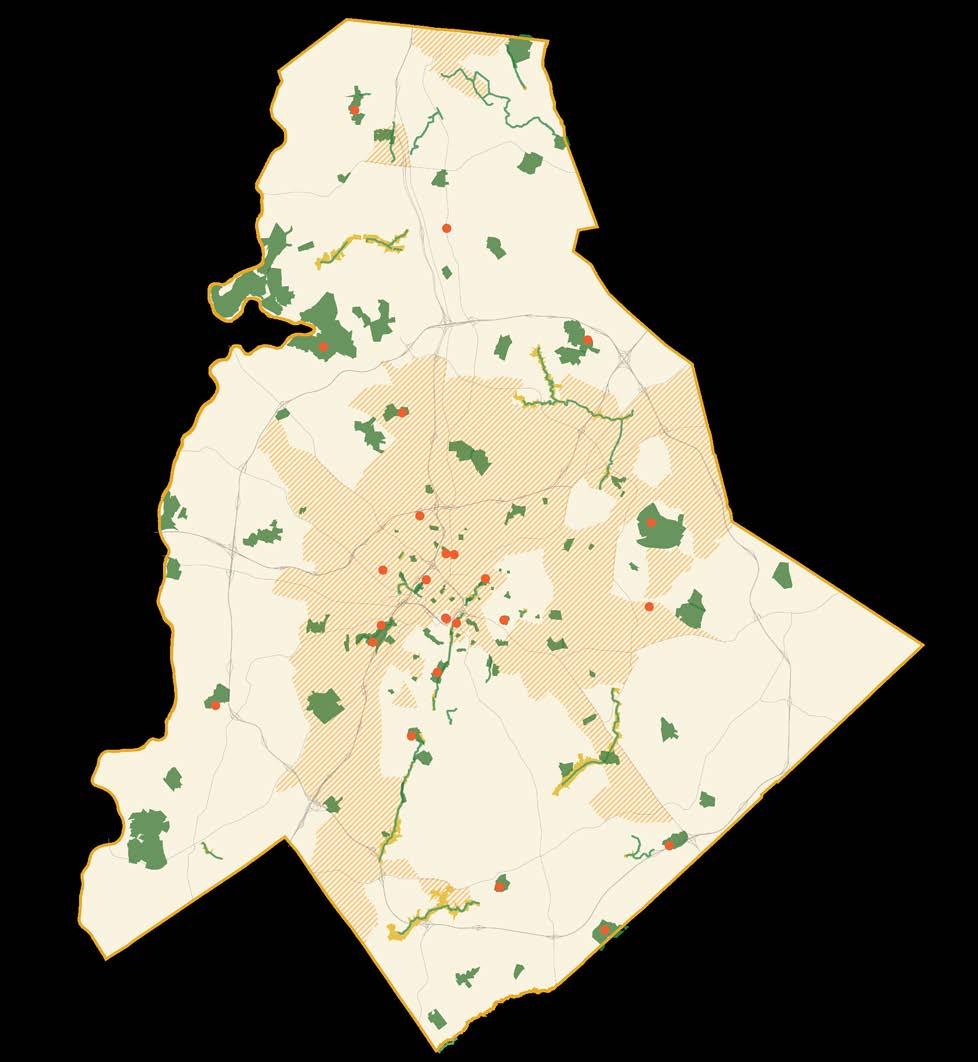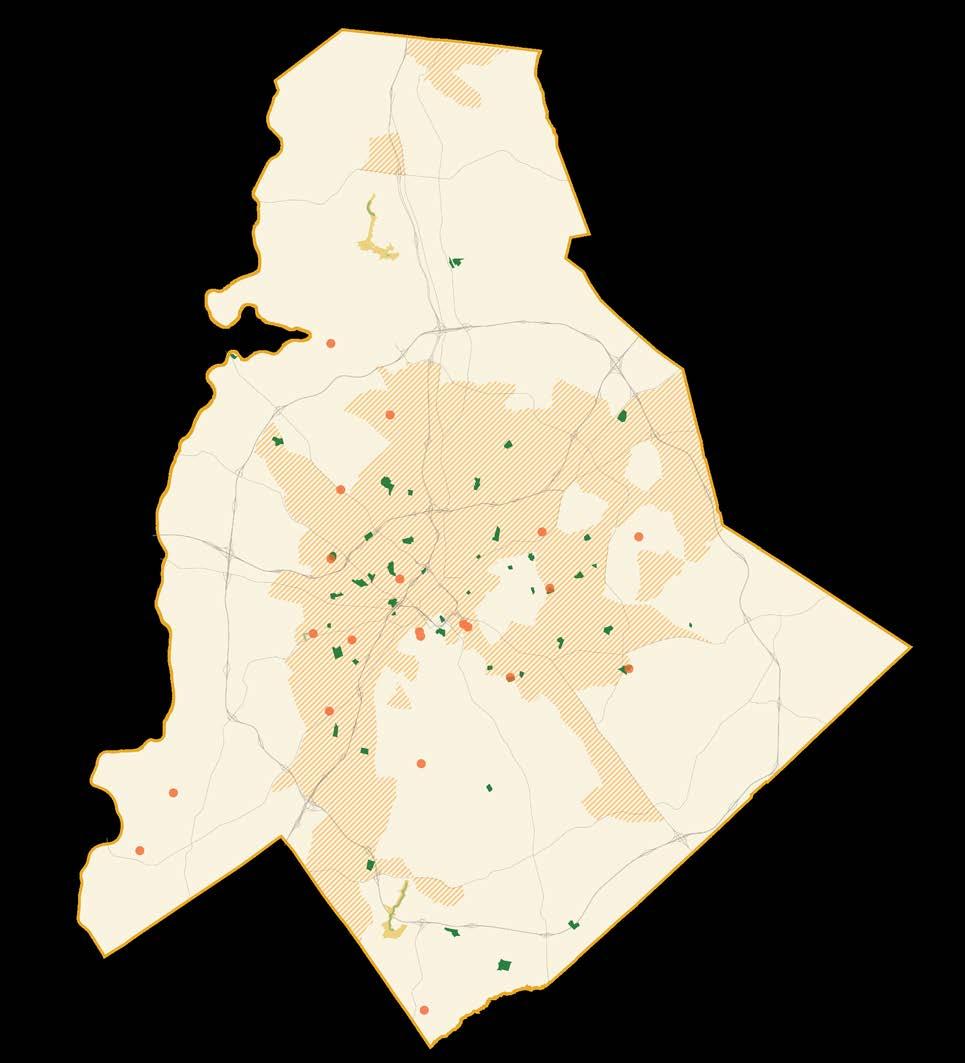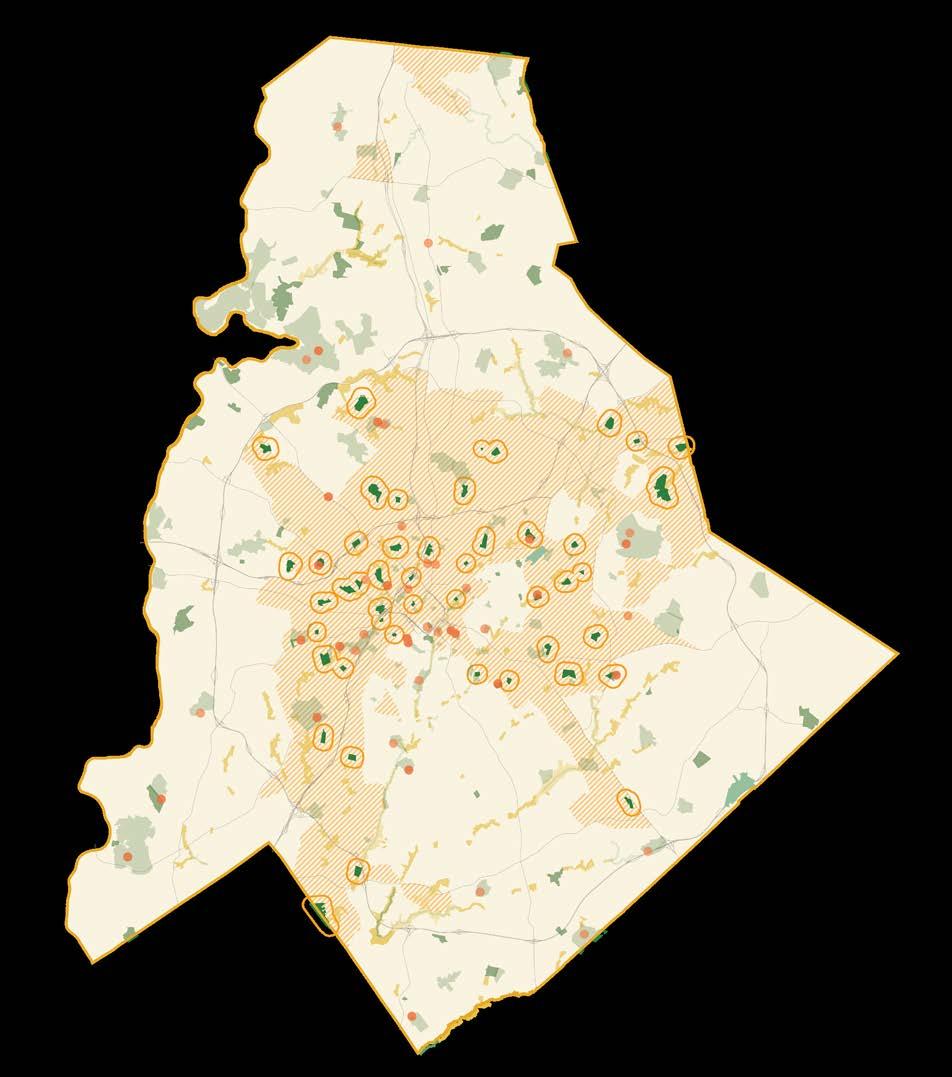
5 minute read
Preseason Inventory
Preseason
Inventory and Assessment
Advertisement
It is essential to clearly understand the condition of the open space and facility network. Such knowledge prioritizes both short-term and long-term investment and reinvestment in targeted ways. To this aim, an on-the-ground inventory and assessment of parks, greenway trails, nature preserves, open spaces, historic sites, and sports and recreation facilities was conducted. The inventory included furnishings, accessibility, wayfinding, and signage. Both quantitative and qualitative data was used to compare Mecklenburg’s assets. Quantitative data included the count of amenities, like playgrounds, recreation centers, restrooms, and seating, while the qualitative assessments graded the condition, function, and design of each space using an A-F rating system. To conduct the inventory and assessment, a dozen members of the Meck Playbook team, including Department staff and the consultant team, visited spaces from October 2019 through February 2020. Recognizing the subjective nature of the qualitative assessments, the team ran internal trainings and cross-checked scores at various milestones with the County staff to ensure consistency. The team used an online geospatial tool, ArcCollector, to catalogue the inventory. This platform was selected because it allowed the team to add data to County’s existing GIS framework from the field in real-time. The inventory provides a snapshot of the conditions today, which – in conjunction with staff and community input – inform the strategies set forth in this master plan. The inventory is not intended to be a static document frozen in 2020. Instead, it is a malleable online tool that must be updated regularly by Department staff to remain relevant and effective. It will be critical to update the inventory, in order to benchmark progress, identify emergent gaps/issues, and prioritize future investment (See Strategy 2.1 for more detail).
Key Findings
Levels of investment, programming, and maintenance vary greatly across parks, facilities, and greenway trails. In general, large parks, preserves, and greenways, which were the original focus of the County’s park department, are in excellent or good condition, are safe, and have a lot to offer (See Figure 1.11). Most often, these types of places are newer, like Harrisburg Road Sportsplex. Contrastingly, many park properties built by the City prior to 1992, including neighborhood parks and recreation facilities (See Figures 1.12 and 1.13), need updates. Devonshire Park is a good example. These spaces are often older, very well-loved, and in neighborhoods with dense activity and high use. Many of these parks have not seen recent substantial Capital Improvement Plan (CIP) or community led investment beyond the replacement of amenities. In addition, limitedaccess parkland on the edges of the County, as
Inventory Findings
Parks ranked highly Greenway land ranked highly Facilities ranked highly Greenway Trails ranked highly Priority communities
1.11 A detailed inventory process found that large parks, preserves, and greenways are doing well.
well as greenway corridors without trails, offer considerable ecological benefits but are being threatened as development takes precedence in the County.
A Closer Look
All observed open spaces, trails, and facilities were reviewed against a number of tangible and qualitative criteria. This criteria ranged from the number and condition of trails, play equipment, and wayfinding signage, to the accessibility and safety considerations in parks. It also looked at the condition of structural systems, building envelopes, building systems, and interior finishes. Finally, it documented the level of activity within the building, the building’s visibility from the street, the maintenance condition, and implied visitor safety in facilities. The goal of the effort was to establish a template criteria and rating system for the Department to modify and use for future documentation of open spaces, trails and facilities, to assist in identifying common themes across facilities, and to assist in understanding where resources should be invested next. For all assets and their rankings, please see Appendix 3.
Parks & Open Space
Mecklenburg County is home to about 21,000 acres of County-owned open space and parklands. These lands were reviewed based on their 2008 and 2015 park classifications: Regional Parks, Community Parks, Neighborhood Parks, Nature Preserves, and Golf Courses.
The inventory revealed that over two thirds of the Regional Parks and half of the Nature Preserves are in good condition (A or B grade). Similarly, half of the County’s six Golf Courses are in excellent condition. The conditions in Community Parks are more varied. The new Clarks Creek Park, for example, is in great shape, while others, like Albemarle Road Park, need investment to address issues of activation and maintenance. Lastly, more than half of the
Neighborhood Parks, which provide a critical, walkable recreational service for residents, require investment to update aging equipment and infrastructure. Facilities
County-owned facilities meet a broad range of needs for public users and staff alike. The current condition of these facilities is equally varied. The assessment discovered that aquatic facilities were observed to be in the best condition of all facilities throughout the system, and pavilions and senior centers followed. Recreation Centers and Nature Centers varied greatly, with each type having both new buildings and a number in need of reinvestment.
Non-public facilities, such as administration or maintenance facilities, are generally in need of reinvestment.

The condition of the buildings were generally distributed evenly across Mecklenburg County, and no clusters of underinvested areas were present. Newer and recently renovated buildings are distributed in a similar manner as those
Inventory Findings
Parks needing updates Greenway land needing updates Facilities needing updates Greenway Trails needing updates Priority communities
1.12 Many neighborhood parks and facilities need updates, especially in priority communities.
that are in need of reinvestment. While many
of the older facilities are well-loved by the community, building envelopes, building
systems, and interior finishes have aged, as deferred maintenance is a recurring theme. Incorporation of technology varies greatly from building to building, with newer and recently renovated buildings providing greater technology offerings than older facilities. Irregularities in
sign branding (like between Flat Branch Nature Preserve and Mallard Creek Community Park) and wayfinding are present in many places
across the system. Additionally, some buildings are not identified at the street, or the front door to the facility is obstructed or hard to find. Site lighting, maintenance, and visitor visibility varied greatly across the system as well.
Greenway Trails
Compared to other parks and open space amenities, greenway trails are a relatively new endeavor for the County. As a result, the
greenway trail system is in great shape overall,
with nearly three quarters of them scoring an A or B in the assessment. Trails receiving low marks were frequently due to pavement that created inaccessible conditions through eroded gravel or aging and cracking asphalt.

1.13 Most of the lowest rated parks fall within priority communities. When mapping conditions such as percent of renters, higher rates of poverty, rates of youth and adults over 65, and a higher population of non-white residents, we can map where reinvestment should take priority. Inventory Findings Paired with Community Need
Low-ranked parks/greenways in priority communities Low-ranked parks/greenways outside priority communities
High-ranked parks/greenways
Low-ranked facilities inside priority communities
Low-ranked facilities outside priority communities
High-ranked facilities
Priority communities










